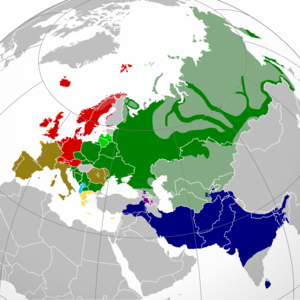Indo-Iranic languages
The Indo-Iranian languages or Indo-Iranic languages[1][2] are the largest group of the Indo-European language family. They include the Indo-Aryan (Indic[note 1]) is the reconstructed proto-language of the Indo-Aryan languages.[3]) and Iranic (Iranian) languages. They are mostly spoken in the Indian subcontinent and the Iranian plateau. Originally, they were spoken in Central Asia, to the east and the north of the Caspian Sea.
| Indo-Iranian (Indo-Iranic) | |
|---|---|
| Indo-Iranic (Aryan) | |
| Geographic distribution: | Eastern Europe, Western Asia, South Asia |
| Linguistic classification: | Indo-European
|
| Proto-language: | Proto-Indo-Iranian |
| Subdivisions: | |
| ISO 639-5: | iir |
 The general location of Indo-European speakers in Europe and Asia.
Indo-Iranian | |
Indo-Aryan languages
changeThere are about 221 Indo-Aryan (Indic) languages, with more than 800 million speakers.
Below are the most widely spoken Indo-Aryan languages.
- Punjabi (regional official language in India; regional de facto co-official provincial language in Pakistan)
- Bengali (official language in Bangladesh; regional official language in India)
- Marathi (regional official language in India)
- Hindustani (in the form of Urdu; official language in Pakistan; regional official language in India alongside Hindi, another form of Hindustani)
Sanskrit, the sacred language of the Hindus, is also an Indo-Aryan language. Today it is spoken by around 14,000 people, is an official language in the Indian state of Uttarakhand, and is one of the 22 official languages of India.
Iranic languages
changeThere are about 86 Iranian languages, or Iranic languages as argued by some scholars,[4] with between 150 and 200 million speakers.
Below are the most widely spoken Iranian languages.
- Persian (official language in Iran; also official as Dari in Afghanistan and as Tajik in Tajikistan)
- Pashto (official language in Afghanistan)
- Kurdish (official language in the Kurdistan Region of Iraq)
The Iranian languages also contain the extinct language Avestan, which is used in the Zoroastrian scriptures of Zoroastrianism. It is similar to Sanskrit but is not widely spoken today.
Nuristani, Bangani, and Badeshi
changeSome scholars consider the Nuristani and Bangani languages as part of the Indo-Aryan subgroup, but some other scholars consider them as two separate subgroups of Indo-Iranian. The Badeshi language is also an unclassified Indo-Iranian language.
Further reading
change- "Contact and change in the diversification of the Indo-Iranic languages" (PDF). Dr. Russell Gray.
- Kümmel, Martin. "Substrata of Indo-Iranic and related questions." Loanwords and substrata. Proceedings of the Colloquium held in Limoges (5th–7th June, 2018). 2020.
- Pinault, Georges-Jean. "Contacts religieux et culturels des Indo-Iraniens avec la civilisation de l'Oxus". In: Comptes rendus des séances de l'Académie des Inscriptions et Belles-Lettres, 149ᵉ année, N. 1, 2005. pp. 213–257. DOI:https://doi.org/10.3406/crai.2005.22848 ; www.persee.fr/doc/crai_0065-0536_2005_num_149_1_22848
- Pinault, Georges-Jean. "La langue des Scythes et le nom des Arimaspes". In: Comptes rendus des séances de l'Académie des Inscriptions et Belles-Lettres, 152e année, N. 1, 2008. pp. 105–138. DOI:https://doi.org/10.3406/crai.2008.92104 ; www.persee.fr/doc/crai_0065-0536_2008_num_152_1_92104
- Baly, Joseph. Eur-Aryan roots: With their English derivatives and the corresponding words in the cognate languages compared and systematically arranged. Vol. 1. K. Paul, Trench, Trubner & Company, Limited, 1897.
Notes
change- ↑ In modern and colloquial context, the term "Indic" refers more generally to the languages of the Indian subcontinent, thus also including non-Aryan languages like Dravidian and Munda. See e.g. Reynolds, Mike; Verma, Mahendra (2007). "Indic languages". In Britain, David (ed.). Language in the British Isles. Cambridge: Cambridge University Press. pp. 293–307. ISBN 978-0-521-79488-6. Retrieved 2021-10-04.
References
change- ↑ Rowlett, Ralph M. "Research Directions in Early Indo-European Archaeology." (1990): 415-418.
- ↑ Heggarty, Paul. "Europe and western Asia: Indo-European linguistic history." The global prehistory of human migration (2015): 157-167.
- ↑ Cardona, George; Jain, Dhanesh (26 July 2007). The Indo-Aryan Languages. Routledge. ISBN 9781135797119. Retrieved 24 October 2015.
- ↑ Kümmel, Martin Joachim. "Iranic vs. Iranian." Update of Mar 30 (2018).